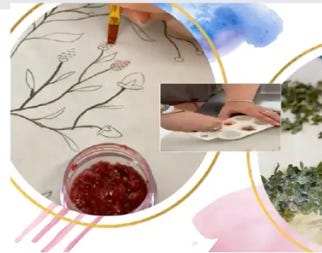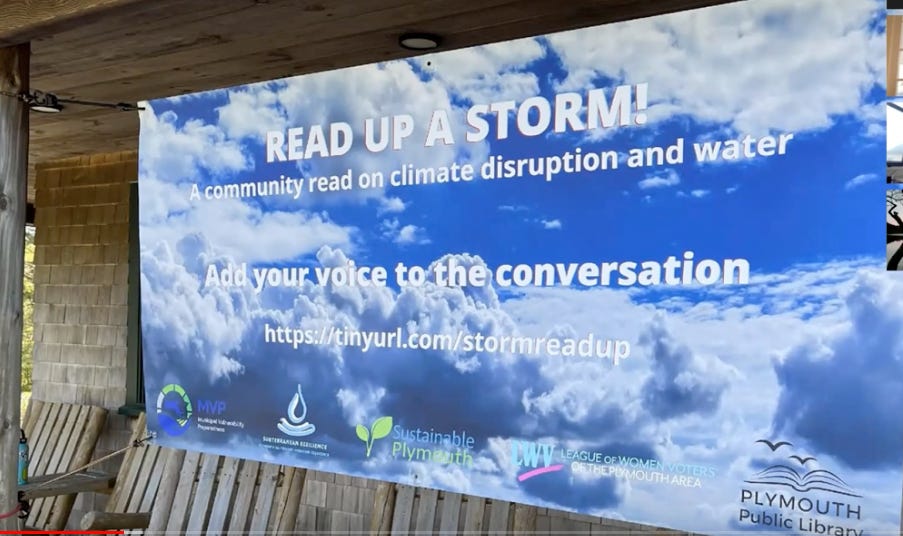Subterranean resilience – what? I hadn’t heard the phrase until I attended a January 2023 webinar about municipal climate resilience and readiness projects funded by grants from the Massachusetts Vulnerability Preparedness (MVP) program. The webinar showcased three laudable projects, but the Plymouth Subterranean Resilience Project caught my attention for a couple of activities that are potentially relevant to museums.
Plymouth like most Eastern shorefront communities face the usual climate threats, especially sea level rise. The “subterranean” focus of Plymouth’s project stems from the threat of saltwater intrusion into Plymouth’s sole aquifer and on its rare pine barrens habitats. The One Water project had over a dozen partners including the town’s Department of Planning; the Herring Pond Wampanoag Tribe1; hydrogeology researchers from University of Massachusetts, Amherst; multiple local environmental and civic engagement organizations; and the local League of Women Voters. Sadly, no museums as far as I can tell, but a significant chunk of the project was informal education, so there are plenty of ideas worth stealing.
Like the Mount Desert Island Historical Society’s Landscape of Change project, Plymouth’s project incorporated many of the recommended best practices in climate resilience education promoted by Action for Climate Empowerment and NOAA: It focused on a critical local issue, meaningful local partnerships including with the indigenous community, and increasing community climate literacy.
Each of the partner organizations conducted a related project that made sense to their mission and their stakeholders, and there was tremendous collaboration between the parties. I confess that I still can’t quite get it all in my head, but a few of the activities included educational heritage walks on tribal lands and plant-based art-making programs by the Herring Pond Wampanoag tribe, aquifer-focused educational hiking trails lead by the Wildlands Trust, and a website and blog by the Living Observatory.

I’m going to focus on just two takeaways below, but if you’ve got a half-hour, it’s well worth hearing about the rest of the project in this video of the webinar (minutes 7: 35 to 40:25). I was especially taken by the “lessons learned” discussion at the end of the presentation. Two organization leader drive home how well the project emphasizes the socio-scientific nature of the project.
“The Read Up a Storm [book club] and the One Water website … have been just wonderful. … As indigenous people, we often struggle to figure out where we fit in and how our knowledge will incorporate with western science. … For us, the traditional knowledge comes easy… We know we’ve been affected by saltwater intrusion because now the bays where we used to be able to fish and get our scallops … [the] fishing is no good anymore. For us, our ‘lessons learned’ are the western science … we’re not scientists, but we are, in another way.
~Melissa Ferretti, Chairlady/President of the Herring Pond Wampanoag Tribe
“[Melissa] brings up such a wonderful point. One of the reasons for trying to make awebsite is to allow with multiple perspectives to be present and to show up so that people understand. We’re not all science and science can’t totally solve the problem. Understanding the role of nature and readjusting our relationship with nature, which is what Melissa does so wonderfully is equally important.”
~ Glorianna Davenport, co-founder and President of Living Laboratory
Takeaway One: Planners (and their Colleagues) Need Data
Data-driven decision-making would seem to be critical to planning … anything. But I think we’d all be surprised by what data our city and town staff don’t have at their fingertips. (Heck, coastal zone communities have to work around the fact that FEMA flood maps don’t account for predicted sea level rise.) Before the MVP grant, the existing hydrogeological models of the aquifer did not account for the groundwater interactions with streams or Plymouth’s 365+ ponds. Imagining trying to decide where to allow new wells and septic systems when you have to rely on a fantasy model of how water moves underground.
As part of the MVP project, UMass Amhert geoscientist Dr. David Boutt developed an aquifer model that does account for interaction between surface and ground water. That model was then ground-truth tested by community science. Data gathered by volunteers of the Plymouth Saltwater Intrusion Task Force informed the next iteration of the model before it was used to predict saltwater intrusion. A legacy of the project is the Southeastern Massachusetts Pine Barrens Alliance’s community water testing station, which will allow residents to test their own water samples.
If your museum is running – or considering running - a community science project, I suggest talking with local government officials. They might need your data (as happened with the Science Museum of Virginia’s heat mapping project) or suggest a focus for your next project. And don’t just focus on planning agencies. A former colleague now works for a college consortium, which was recently approached by the Worcester Health Department, asking for assistance well beyond public health student interns – GIS, education, and communication students, and “any data you have” that might impact health. Take a look at the list of departments, committees, and projects on your municipal website: Health Department, Public Works, Parks and Recreation, Transit, Urban Forestry, Housing & Neighborhood Development, Historic Preservation, the list of offices that needs to make plans for the future is long!

Takeaway Two: Book Clubs Reimagined
The Sustainability Committee of local League of Women Voters and the Plymouth Public Library created a community read called Read Up a Storm. Instead of asking everyone in town to read a single book, Read Up a Storm went broad. The library created a list of books (now over 100 books long) all focused on water, from a diversity of authors and in multiple genres: non-fiction science and memoir, but also fiction including fantasy and science fiction.
The League and Library created a list of discussion questions and offered discussion facilitators for local book clubs. They also hosted three community-wide sessions where attendees could discuss a book that impacted them. These open events were seeded with “ringers”: the state senator, town employees and officials, and others active in environmental work. Finally, library staff came with “armloads” of books from the reading list to display at the community events.
I love everything about this book club project. As a terribly slow reader, I appreciate that I could have participated on my own terms, reading a book that suited my own interests, time, and mood. I love that it offered support to existing book clubs, again with the open choice of books, and with free facilitators. And I love, love, LOVE the idea of the display of books at the event.
A week after watching the webinar, I suggested to a client museum that they try to entice their local library to create a temporary display of science books at one of their family science nights. At my old job, the library brought its bookmobile van to our kindergarten readiness event. The event set records for the number of sign-ups for new library cards. I would hope that a book table at a family science night might similarly drum up new business for your library. I can’t guarantee that every library will have the capacity to send books and a staff person to your event, but the reference person at my local main library said that they’d certainly try to accommodate such requests, with plenty of notice (and presumably with an understanding of the likelihood that you’d be delivering a lot of potential new patrons).
Worth a Shot?
Both of these takeaways seem worth a conversation or two with folks in town. Please let me know if they strike a chord or remind you of something you’re already doing.
~ Betsy Loring2
The Planning-Curious Museum Person
Sharing stories and ideas for other Planning-Curious Museum People and for Museum-Curious Planning People.
The participation by the Herring Pond Wampanoag Tribe in a project that involved Plymouth town officials is no small thing and, I think, shows a lot of grace on the part of the individuals involved. As one highly visible locus of colonial genocide, Plymouth has given local Indigenous people ample reason not to give that grace. This account of the Wampanoag perspective on Plymouth’s 350th Anniversary “Celebration” is just one glimpse into that history. Plymouth is busy planning is 400th Commemoration (rather than “celebration”) with a bit more awareness and sensitivity. The Plymouth 400 website (which still has a very red-white-and-blue vibe) includes the Wampanoag history and context in the exhibit “OUR STORY: 400 Years of Wampanoag History” developed by the Indian Spiritual and Cultural Training Council and the Indigenous-led exhibit, marketing, and communications firm Smoke Sygnals.
Betsy Loring is founder of expLoring exhibits & engagement. She has over 20 years’ experience in project management and exhibit development in multidisciplinary, indoor and outdoor museum settings. Her services include exhibit master planning, content and interactive development, and writing, with a focus on hands-on STEM. She also offers staff training in exhibition planning, formative evaluation, and prototyping. Special interests include multi-institutional collaborations, peer-to-peer professional development, and of course – collaboration with municipal planning practitioners.



